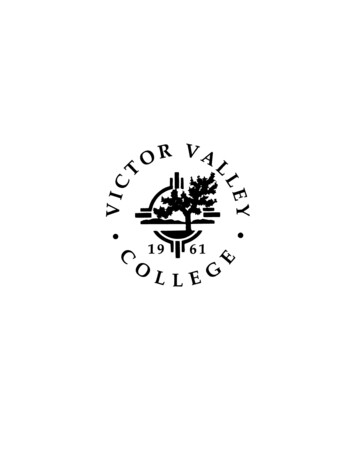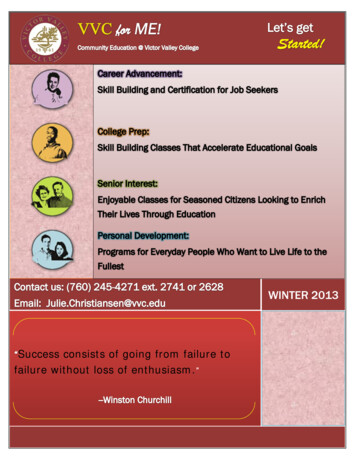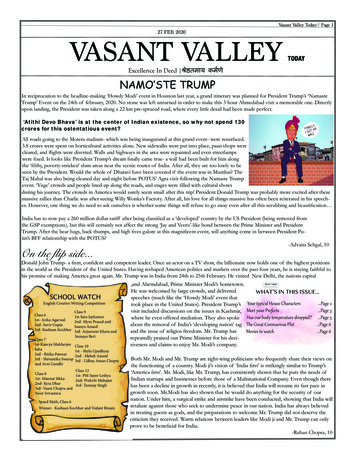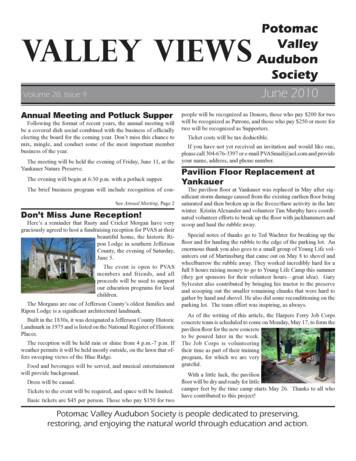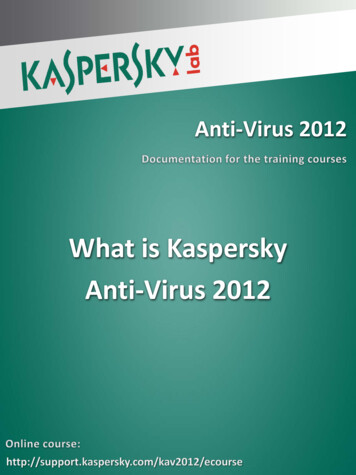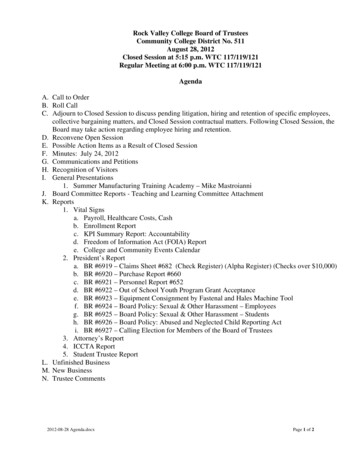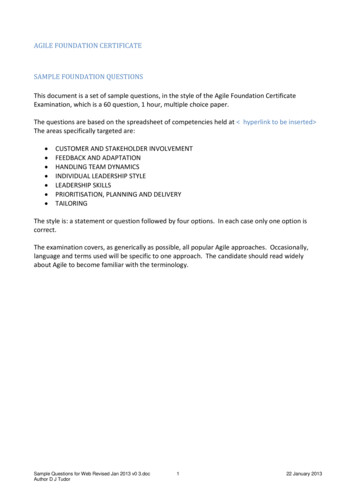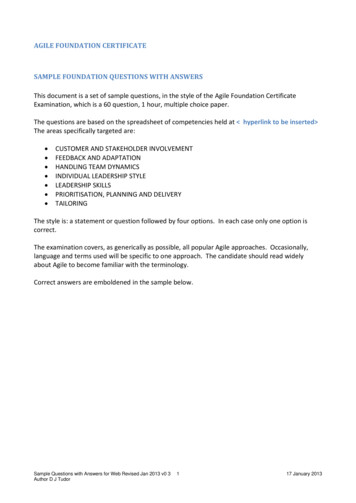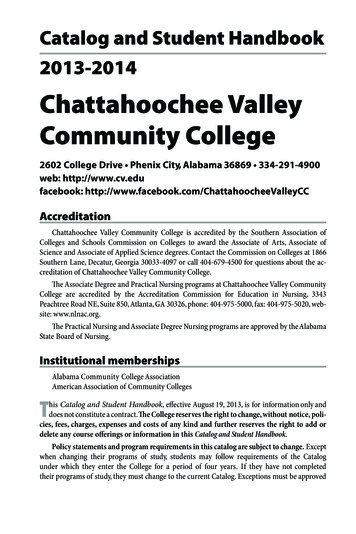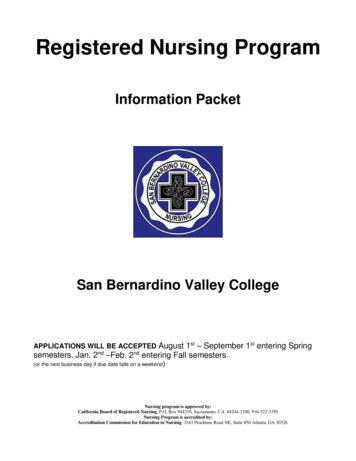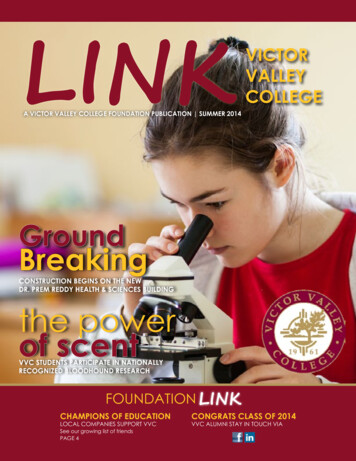
Transcription
LINKVICTORVALLEYCOLLEGEA VICTOR VALLEY COLLEGE FOUNDATION PUBLICATION SUMMER 2014GroundBreakingConstruction begins on the newdr. prem reddy health & sciences buildingthe powerof scentvvc students participate in nationallyrecognized bloodhound researchFOUNDATION LINKCHAMPIONS OF EDUCATIONLOCAL COMPANIES SUPPORT VVCSee our growing list of friendsPAGE 4congrats class of 2014vvc alumni stay in touch via
SaturdaySeptember 6, 20142nd Annual10:00 am 7:00 pmFilm & MusicFestivalCINEMA WEST THEATRE CIVIC PLAZA 12& HESPERIA CIVIC PLAZA PARK9711 NINTH AVEHESPERIA, CA 92345FILM AND MUSIC EVENT INC.
ContentSummer 201408GROUND BREAKINGConstruction begins on the newDr. Prem Reddy Health & SciencesBuildingquick link0507111314at VVCI LEARNEDthreeWhen I started at VVCowkntyears ago, I did noI havedivision. Since then,d will beanluslcuCamastereds year.thiereceiving my degreBen ElmagarisygineeringMajor: Biomedical EnTHE POWER OF SCENTVVC’s Bloodhound Clud researhces the power of scent.cementing chemisTryMitsubishi Cement and Cemex discuss the importance ofChemistry when it comes to making cement.SCIENCE WINTERNSHIPSVVC students to participate in NSF sponsored research programat CSUSB.I learned that my motivationmust be forceful in order toovercome obstacles that cancome my way.Alyssa ZuiderveldMajor: Physicians AssistantOPERATIONS INTERNVictor Valley Wastewater Reclamation Authority Operator BobbyHesse dicusses why math & science are important.CAREER LINKSOutlook on jobs for career ladders and the Victor Valley Collegeprograms that prepare graduates to get them.The LINK is a publication of theVictor Valley College Foundation18422 Bear Valley Rd., Victorville, California 92395760.245.4271 ext. 2522 www.vvcfoundation.comund myselfI learned to surrod peoplewith open-mindeto get aemthat motivateng throughdianrstdedeeper uneducation.anetskiyValentin PishchTherapyrytoMajor: Respira
LINK04Victor Valley CollegeBoard of TrusteesDennis Henderson, PresidentJoseph W. Brady, Vice PresidentJohn Pinkerton, ClerkLorrie Denson, TrusteeBrandon Wood, TrusteeEvelyn Blanco, Student TrusteeVictor Valley CollegeFoundationThese generous organizations have made an annual commitment tosupport the events and activities that fund the important work of theVictor Valley College FoundationBoard of DirectorsOfficersDon Brown, President - Lee & AssociatesFrank Robinson, Vice President - Town of Apple ValleyEric Schmidt, Vice President - Exquadrum, Inc.Dawn Serbus, Vice President - Citizens Business BankCaroll Yule, Vice President - Shear RealtyDonna Wells, CPA, TreasurerVal Christensen, Past President - Johnnie D’s RestaurantPeter Allan, Superintendent - Victor Valley CollegeDirectorsMerlin Aalborg - Heritage Victor Valley Medical GroupTim Anderson - El Dorado BroadcastersCasey Armstrong - Armstrong Fairway InsuranceMagdalen Chavez - VVC ClassifiedLarry Cusack - Apple Valley CommunicationsSteve Davisson - Chino Commercial BankDianna Donofrio - Apple Valley Physical TherapyBruce Ebmeyer - Ebmeyer CharterCraig Garrick - ComAvNorm Hurst - Community MemberGH Javaheripour - VVC AdministrationScott Jones - VVC FacultyJerry Klein - State Farm InsuranceJason Lamoreaux - Coldwell Banker CommercialScott Nassif - Napa Auto PartsDeedee Orta - VVC ManagementSuzanne Richards - Victor Valley Global Medical CenterT. Kirk Riding - Capstone ConsultingBill Scott - Scott Turbon MixerPaul Stanton, MD - Ultimate Sports & OrthopedicsThurston Smith - Community MemberEvonne Torres-Tirado - VVC StudentEmeritusPercy Bakker, EmeritusBruce Fay, EmeritusJanice Olson, EmeritusJoe Range, EmeritusStaffGinger Ontiveros, Executive DirectorCatherine Abbott, Assistant DirectorJames Johnson, Contract Education ManagerRhea Deroian, Grant Development ManagerGlennis Duncan, Executive Assistant / FinanceJesika Pomponio, Special Events & Volunteer CoordinatorGabriela Callender, Advancement AssistantYou can change lives.Your tax deductible gift to the Victor ValleyCollege Foundation will change lives. Donations providescholarships for deservingstudents, purchase trainingequipment for classrooms andallow students to participate inlife-changing extra-curricularactivities.Gifts can be madeeasily online at the Foundationwebsite:at VVCI LEARNEDwww.vvcfoundation.comI learned how to palpatehorses ovaries.aKaryssa DennisonMajor: Applied SciencesThank YOU for Caring
The power of scentLINK05VVC students participate in nationally recognized bloodhound researchImagine a loved one going missing withouta trace. No word, no clues, no witnesses, justgone. What would you do? Who could help findsomeone with no evidence to go on? The answer:Bloodhounds, the next generation of detectives. Dr.Lisa Harvey, VVC Professor and Biology DepartmentChair, is a leading bloodhound expert in the UnitedStates. Her bloodhounds have been used to findnumerous people and assist in countless policeinvestigations. Her dogs follow the trail no oneelse can. In fact, Dr. Harvey’s research shows thatbloodhounds can trail a scent from a fired shellcasing, trails that have been contaminated (walkedand driven across) by more than a million people,trails at least 40 miles long, and even follow a scenttrail of a person in a car. It’s not magic or “dogvoodoo”, it is just a remarkable skill that can behoned for the benefit of society.VVC’s Bloodhound Club, managed by Dr.Harvey, is dedicated to establishing the scientificliterature behind the ability of the bloodhounds totrail human scent. Bloodhounds are used widely bylaw enforcement to trail criminals, prove a suspect’sguilt, or to find abducted children. Another use forbloodhounds is to locate human remains in case ofearthquakes or other disasters.The club consists of a group of studentsenrolled in BioH295 (Biological Science Reserach)who are trying to gain experience in the field ofscientific research. Students in the courseconduct field studies anddocument their researchto create a repositoryof information thatcan help humansunderstandthe abilities ofthese canines.They also workhands-on in trainingand trailing exercises withthe bloodhounds, whichoften start training as young as seven toeight weeks old. Bloodhounds take about18 months to be fully trained and gaina veteran status. Often they will havespecialty types of scents they track, fromtrailing abducted children, to narcotics,arson, searchand rescue,human remains,or bombdetection.Theselittle detectivesare not justsmart andtalented,they arededicated too.In one studyconductedby Dr. Harvey,veteranbloodhoundsDr. Lisa Harvey andwere able toAston Martin, the Bloodhound.trail a scent with96% accuracydespite the trail being laid up to 48 hours earlier withvarying weather conditions, including 1.5 inches ofrain and winds up to 60 miles per hour.A bloodhound’s nasal cavities, where scentsare identified, are significantly more impressive thanany other dog breed. Bloodhounds have fourbillion olfactory (scent) receptor cellscompared to only five million in humans.A bloodhound olfactory epitheliumhas a surface area of 59 squareinches, compared to human’solfactory area of 1.55 squareinches, 10 square centimeters.The substantial, long saggingears help to thwart wind fromdisplacing nearby skin cells whilethe bloodhound’s nose is on theground; the wrinkles around themouth and neck, called the shawl,function to capture stray scentparticles in the immediate area asthe dog is scenting, reinforcing theparticular scent for the canine.William Tolhurst, a masterbloodhound handler, said in his bookManhunters (1984): “Scent is the one pieceof evidence that must be present at thescene of a crime.The criminal may walk on a concretefloor and leave no tracks, wear glovesand leave no fingerprints, but unless theentire area has been burned,Continued page 12: Bloodhounds
1994-2014
Cementing ChemistryLINK073Cao 2si02 4H20The Hoover Dam weighs 6,600,000 tons, theChesapeake Bay Bridge in Maryland is one of thelongest bridges in the world spanning 22,790 feetand a famous wonder of the ancient world “TheGreat Pyramids” are made up of approximately2,500,000 stones. What do all of these monstrousiconic structures have in common? They areall made out of millions of tons of concrete.While concrete is a simple mixture of paste andaggregates (or rocks), it must have the right“Chemistry” to support these “mega structures” wenow benefit from.You may be surprised to know the HighDesert has the highest concentration of Cementplants on the West Coast. There is a very goodreason why. If you look around the region, youwill notice a valley surrounded by mountains.Embedded deep in those mountains are decadesworth of available limestone. This sedimentary rockis the basis of making cement which ultimatelybecomes concrete.If you have ever thought of a career asa Chemist, this is an industry to consider. At theMitsubishi Plant in Lucerne Valley and Cemexin Victorville, chemists are very hands on. Everyhour, they are tinkering away closely samplingthe materials to protect the integrity of theircrushed and heated materials. Plant Manager andChemist, Jim Russell says, “the key to achievingthe strong and durable product rests in the carefulproportioning and mixture of the ingredients bythe means of frequent chemical and physicaltests.” In the past, cement analysis was carried outusing wet-chemical techniques. Now, the days offlasks bubbling away over bunsen burners in thelaboratory are largely gone and are replaced byX-ray analysis equipment of various types.The process begins in the quarry mineswhere a few times a week rock is blasted from themountain. While visiting the Mitsubishi Plant, a groupof elementary students on a field trip were in luck.They were given the responsibility of pressing thebutton which detonated the dynamite and blewapart the hillside! Gigantic dump trucks then pickup the three to six foot rocks and deliver their loadto a crusher where the rock is reduced to roughlysix inches in size. While six inches seems small thematerial is still too large to be introduced to theirmassive 2500 degree kilns. A secondary crusher(raw mill or hammer mill) does its job to furtherreduce the rocks to three inches or smaller. “Theraw mill grounds the material to basically a powderContinued page 12: Cementcemex chemistkiln at cemex
LINK08VVC breaks ground on HeMay 16, 2014 marked a momentous day for Victor ValleyCollege with the groundbreaking of the Dr. Prem Reddy Healthand Sciences Building. Dr. Reddy, a longtime Victor Valleyresident and CEO of Prime Healthcare Services, is a substantialsupporter of education and donor to the college. Fridaycelebrated Dr. Reddy’s recent 2 million gift, the largest singlecharitable gift in the college’s 53 year history, to outfit the newbuilding with state of the art classrooms and equipment.“I am humbled and honored by this event. I’m committedto helping in education because it has been so valuable in mylife. I would like to help others to realize their goals.” Dr. Reddysaid in his address at the ceremony. The new 22,000-square-footfacility is expected to be completed by the fall of 2015 and willhouse several classrooms and mock hospital labs. The facility willhelp to decrease wait lists for students enrolling in the institution’simpacted science and health courses.Reddy has spent most of his adult life in the Victor Valley;he built Desert Valley Hospital in Victorville in 1994 and has beencommitted to regional development since. He said the HighDesert community has contributed to his growth while practicingmedicine as a cardiologist for more than 25 years. In 2004, Reddydonated 1 million to VVC in what was then the largest gift in thecollege’s history. The funds were used for programming in severalallied health subjects, and the college honored him by creating the Dr. Prem Reddy School of Health Sciences,an academic umbrella which unites several health care programs including respiratory therapy, paramedic/EMT,and allied health. Since that time Dr. Reddy has contributed through gifts, student scholarships, and partnershipcontracts bringing his contributions to the college to a grand total of 5.5 million.“I’m proud to see so many nursing and alliedhealth students in the school that bears myname and to be a part of their success.”- Dr. Prem Reddy“Dr. Prem Reddy’s friendship with Victor Valley College has already helped thousands of our students tobuild better lives,” said Peter Allan, Victor Valley College Superintendent & President. “His gift now is helping us tostrengthen our programs with better facilities that will serve countless more. We are proud to recognize him withthe naming of the Dr. Prem Reddy Health and Sciences Building.”Dr. Joseph Morris, Director of VVC’s Associate Degree Nursing Program, stated the new building is “anamazing opportunity for the High Desert. Dr. Reddy’s contribution shows his continued support to educate our
LINK09ealth & Sciences buildingstudents and to produce qualitynurses and allied healthcareprofessionals. He has a long historyof supporting allied health programsat VVC and we applaud andappreciate his generosity anddedication to promote studentsuccess.” Dr. Morris believes thenew building, complete withsimulation equipment and a mockhospital, will prepare graduatesto take care of some of the mostcomplex health care cases.The donation, which wasfacilitated by the Victor Valley College Foundation, wasaccepted by VVC’s Board of Trustees who then authorized thepermanent naming of the new building. “He’s not only a majorcontributor, but a visionary,” said VVC Trustee Joseph Brady of Dr.Reddy. “He has a vision and he shares that vision with the entireHigh Desert medical industry. In the big picture, it takes peoplelike him that can help push us and make those opportunitieshappen.” His latest contribution will be made through the Dr. PremReddy Family Foundation, which Reddy and his family establishedin 1986. The Foundation provides scholarships, supports public health care education, and free communityclinics.The new building will serve as a conduit for STEM related programs, especially nursing. It will meet theneeds of the students for future science courses too and prepare them for the workforce of tomorrow.“Education is very close to my heart. Without it, I wouldn’t be here. I was the first to go to school, anyschool, in generations in my family. I’ve seen what the value of education can do for someone.” Dr. Reddystated at the ceremony. “I’m proud to see so many nursing and allied health students in the school that bearsmy name and to be a part of their success.”uoYknTha
Science WinternshipsLINK11Grant partnership gives VVC students new research opportunityImagine a student working side-by-side withNASA scientists writing or evaluating code, or beinggiven the freedom to conduct their own chemistryexperiments. For most students, learning aboutscience happens inside the pages of a text book. Thatis until now. For a few qualified physics and chemistrystudents at Victor Valley College, these hands onopportunities are ready to jump off the page.Victor Valley College has been named asa partner in a five year, 5 million grant from theNational Science Foundation (NSF) secured by CalState San Bernardino. The funding comes throughNSF’s Center for Research Excellence in Science andTechnology or CREST. The program provides supportto enhance the research capabilities of minorityserving institutions through the establishment of centersthat effectively integrate education and research forfaculty and students in the STEM disciplines.For most community college students, valuablehands-on research is unlikely and will not take placeuntil they reach the University level. Laboratory Aideand Instructor in the Physical Science and ChemistryDepartment, John Hoskins, explains why this grantprovides a unique and exciting opportunity.“Community colleges in general are notsupposed to be research oriented, but we havemultiple research opportunities happening and wecan say we are a full research facility for the sciencefield,” Hoskins said. “Hopefully that will have studentslooking and wanting to come here for the sciencefield.”VVC Professor Michael Butros will also beinvolved in the research leading his team of studentsfrom the physics department. Butros, a formerstudent at VVC during the late 1980’s, said when hetransferred (to University) he had no idea abouttryChemiselsle modmolecuundergraduate research.“I wish I had these opportunities,” Butros said.“However, most of these students have not yet madeup their mind as to what they want to do becausethey don’t know how it (physics) is applied in the realworld.”Both students and faculty will receive paid“Winternships” by Cal State through the grant and foreight hours a day intensive research will take placeon the VVC Campus. In the summer of 2015, Butrosplans on taking a few of his students to NASA – Drydenat Edwards Air Force Base and hopefully establish aresearch community. “This will give them the chanceif they want to be an engineer, mechanical engineeror in the aviation field to work with a NASA scientist,”said Butros.Valuable hands-on programs such as thesenot only better prepares STEM students who plan ontransferring to CSUSB or other Universities it makesthem more competitive and is designed to increaseretention and graduation rates for students in theSTEM disciplines. Hoskins says participation in scienceresearch provides practical skills and knowledgethat will jump start a student’s educational andprofessional career.“This will boost up their resume and beimmensely helpful for them,” said Hoskins. When thecommunity college chapter closes for VVC students,Butros also emphasizes the impact this opportunity hason a student’s resume. “Our students are going to gettheir foot in on heavy duty research that is going tohelp them throughout their careers as scientists,” hesays. “If I could fly right now I would fly! This is all aboutour students and to be able to offer them such a greatopportunity is amazing!”Ammonium NitraChloridete, Ammand ZinconiumPowderexplosion
LINK12Continued from page 7: Cementconsistency and then it is put into the kiln,” saidCemex Plant Manager, Cesar Millan. “The kiln cooksthe material and it becomes small balls which is calledClinker.”Millan’s chemist is busy analyzing the dustand dirt looking to see if any iron ore, silica or othermaterials need to be added. “These are introducedin small portions,” said Millan, “We are ensuringthe clinker has the right composition and goodcharacteristics.” However, the product is far frommaking walls, bridges or even a freeway. Chemistsmust add gypsum, a product that gives cementquarry blast - afterthe setting time andflexibility constructionworkers need to set theirconcrete. “If you just addwater to the cementwithout the gypsum thecement hardens rightaway, and you can’t doanything with it,” Millanexplains.clinkerWorking as achemist in a cementplant is unconventional compared to the sterilefacilities in medical and research labs.“It’s not an exact science either, it’s more ofa broad stroke,” Cemex’s Quality Control MangerJim Martin said. “This is not a clean lab, we areworking with dirt and dust but our end result is bridges,buildings and roads. We have people’s safety andlives at stake and we must meet all State and FederalRegulations.”Martin moved from his home state of NewMexico to put his Bio-Chemist Degree to work at theCemex Quarry in Apple Valley. “I like seeing the resultsof my work, I love my boss and I love my job,” Martinsaid.Continued from page 5: Bloodhoundshe still leaves scent You can’t see it. Youcan’t photograph it. You can’t dye it. Youcan’t lift it like a fingerprint. You can’t find it with alaser. You can’t send it to the lab for analysis. But it’sthere, just waiting to be used.” Later, he was evenable to prove that scent particles can evensurvive on bomb fragments after an explosionand that bloodhounds are in fact capable ofpicking up and trailing that scent.Dr. Harvey and
vvc students to participate in NsF sponsored research program at csUsB. 13 OPERATIONS INTERN . VVC students participate in nationally recognized bloodhound research lINk05 The hoover Dam weigh
